Best Scuba Diving in the World: 10 Top Locations
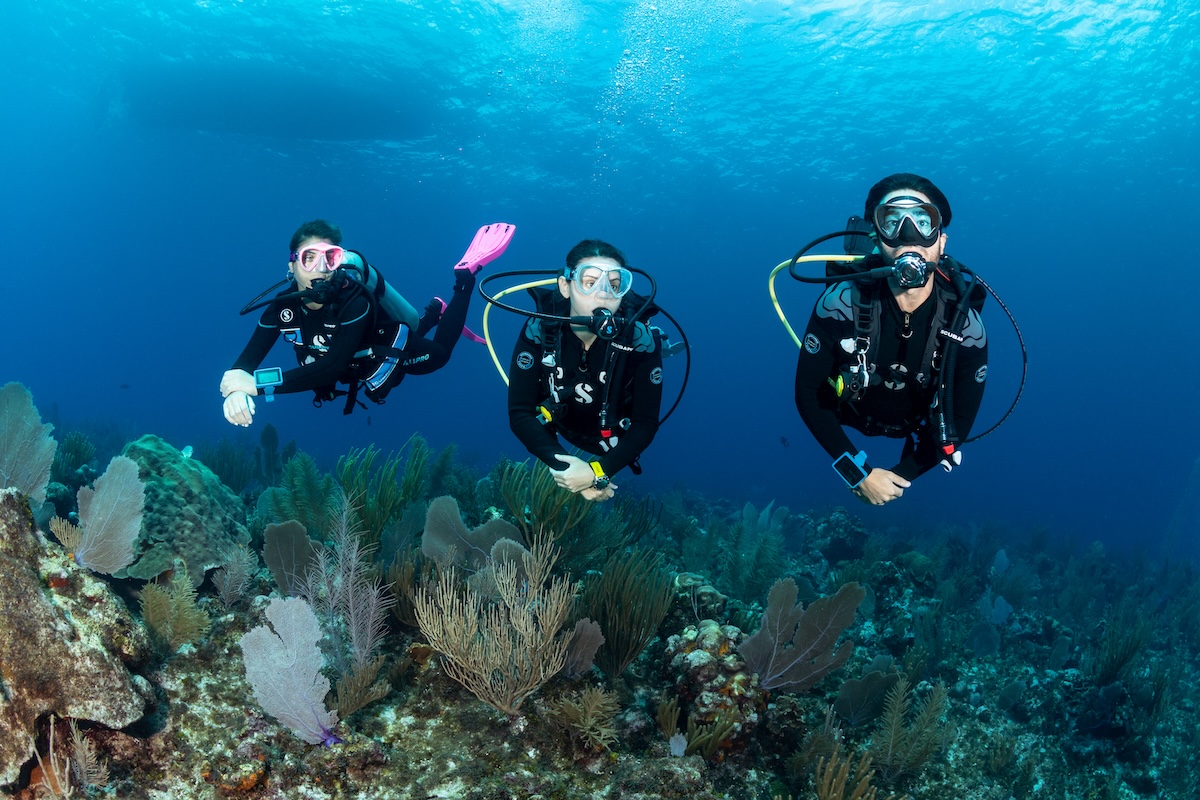
You can scuba dive just about anywhere there’s water. You don’t have to travel far in order to enjoy scuba diving. But seeking out the best dive sites in the world gives you two incredible experiences at once, as you combine the joy of travel with the joy of diving.
No guide could ever encompass every great dive out there. The world is too big to be cataloged in an article, and too full of beauty and opportunity to sum it up in a best-of list. But these scuba diving destinations are some of the best scuba diving locations in the world we’ve found, and they’re worth checking out.
- Great Blue Hole, Belize
- Barracuda Point, Sipadan Island
- Darwin’s Arch, Galápagos
- Maaya Thila - South Ari Atoll, Maldives
- Richelieu Rock, Thailand
- Santa Rosa Wall, Cozumel
- SS Thistlegorm Wreck, Egyptian Red Sea
- SS Yongala Wreck - Great Barrier Reef, Australia
- Yolanda and Shark Reef, Egyptian Red Sea
- 1000 Steps, Bonaire
Great Blue Hole, Belize
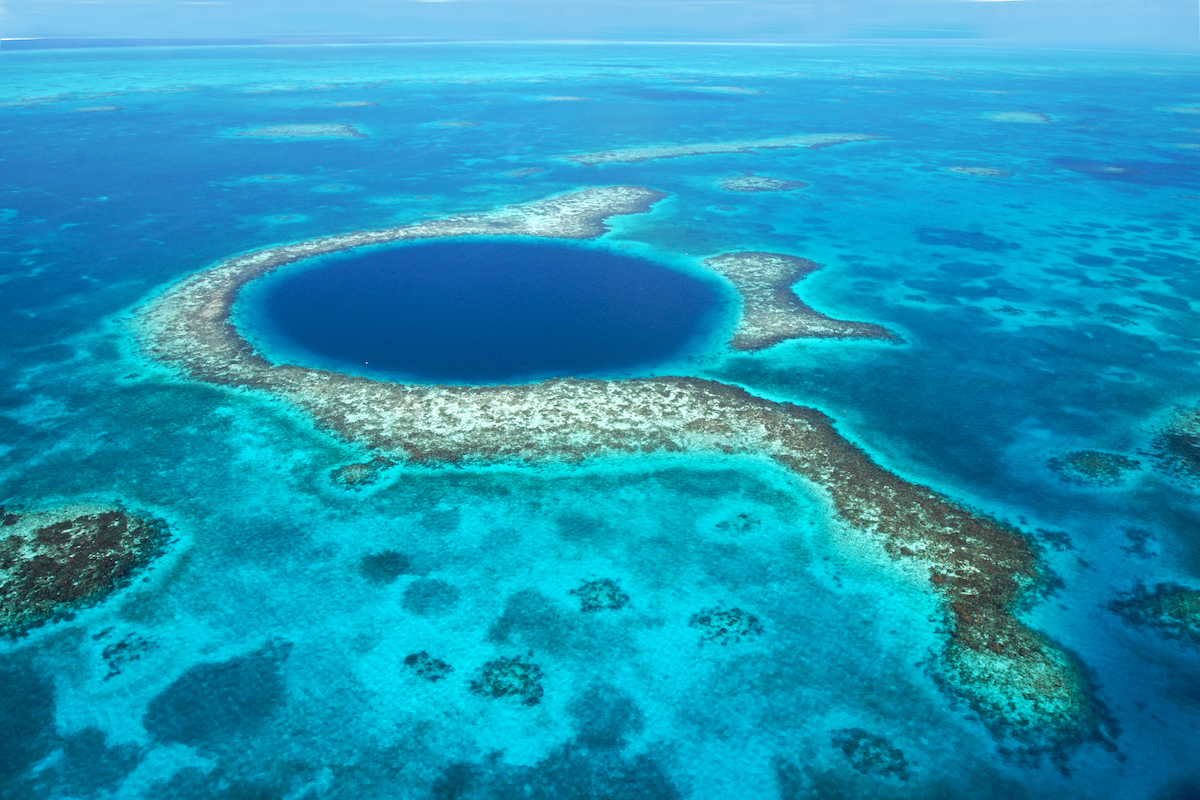
The Great Blue Hole is located off the coast of Belize City at Lighthouse Reef. It’s one of the most unique dive sites in the Caribbean (or anywhere, for that matter). This is the largest ocean sinkhole in the world, and it’s big enough to be seen from space.
Part of enjoying the Great Blue Hole is to know what to expect. This is a deep, dark, serene dive. There are all sorts of unique rock formations down in the hole, including some enormous stalactites and stalagmites.
There are all types of sharks, including blacktip tigers, nurse sharks, bull sharks, hammerheads, and more. You’ll also see angelfish, purple seafans, Pederson’s shrimp, and more.
It’s important to note that the Blue Hole isn’t a “color” dive, necessarily. You may see elkhorn and brain coral in the shallower sections, but this isn’t going to be your typical coral reef dive.
The atmosphere is different. People have described it as “gothic”. It’s quiet, and deep. And while experienced scuba divers can find all sorts of incredible formations and landscape features in the depths between 110 and 270 feet down, it is a bit of a different dive.
Know what you’re in for if you want to make the trip out.
When to Dive the Great Blue Hole
Belize’s climate is diving-friendly all year long, but the best time to dive is between April and June. That’s when the whale sharks arrive in Placencia. From June to November, Belize gets its rainy season, though the rain seldom lasts long, and doesn’t usually affect visibility for boat dives.
Other Great Scuba Diving in Belize
While it’s famous for the Great Blue Hole, Belize has plenty of other world-class dives making it known as a site with the best scuba diving in the world. The country hosts the largest barrier reef in the Northern hemisphere, and the second-largest in the world.
One great dive site within the reef complex is Half Moon Caye Wall. With a vertical drop-off of some 6,000 feet, this dive site is known for its dramatic landscape. It’s also known for lemon sharks, bull sharks, nurse sharks, turtles, rays, and especially its skittish sand eels.
Topside, Half Moon Caye itself is one of Belize’s oldest nature reserves, and it’s vibrant in its own right.
Glover’s Reef Marine Reserve is a World Heritage site on a partially-submerged atoll near the southern coast. Part of the Belize Barrier Reef, the reserve is home to an incredible 800 coral patch reefs across its 135 square miles. It’s one of the few places where divers can see Nassau grouper spawning aggregations, which are becoming more and more rare.
Topside, visitors can explore Mayan caves and ruins between dives. Turneffe Island is the third of Belize’s atolls, alongside Glover’s Reef and Lighthouse Reef. Here you’ll find over 400 islets covered in mangrove shallows, and sites for divers of every skill level.
Of Turneffe’s 70 dive sites, The Elbow is the most popular one, with beautiful drop-offs and reef formations, as well as snappers, jacks, and goliath groupers. The mangrove shallows here help protect juvenile fish, aiding the dazzling diversity of marine life here.
A pod of bottlenose dolphins lives in the south lagoon, and you may see spotted dolphins, as well.To add to the excitement, Manatees and crocodiles will occasionally come through, too.
Learn about more amazing diving locations in our Belize Scuba Diving Guide.
Barracuda Point, Sipadan Island
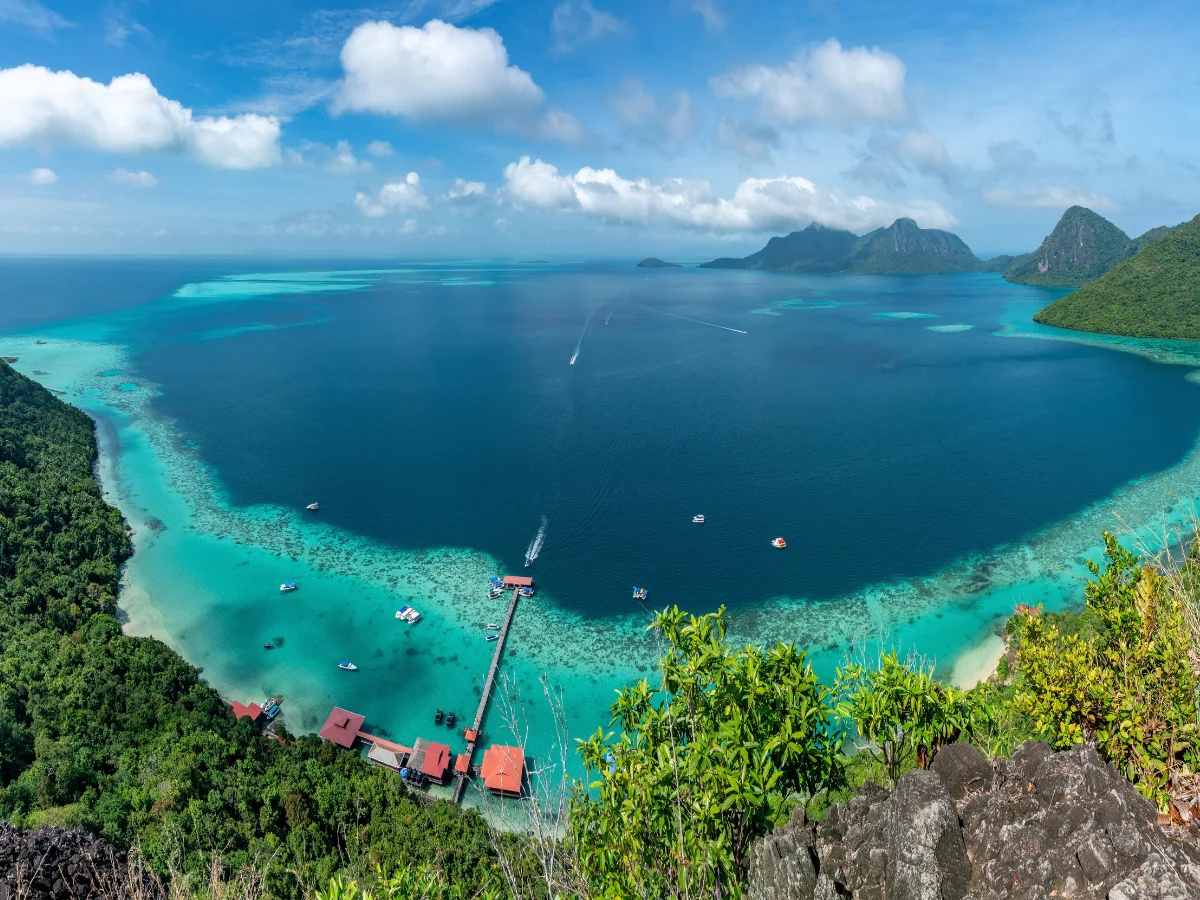
Barracuda Point is located on Sipadan Island, a part of Malaysia that sits in the Coral Triangle. Here, a coral reef has formed around the rim of a dormant underwater volcano, giving rise to a rich, diverse ecosystem in the crystal-clear waters. Over 3,000 species of fish and hundreds of kinds of coral fill these teeming waters.
Barracuda Point is one of Sipadan’s most unique offerings. The dive starts as a wall dive, then becomes a channel with a great current. At the far end is the enormous school of barracudas that give the point its name. Simply calling it a “school” doesn’t really do justice to the sight of it.
This enormous, swarming tornado of shimmering silver is unique, and it’s why underwater photographers flock from all over the world to come to Sipadan. Even without the barracudas, dozens of turtles, reef sharks, parrotfish, and more make this area special.
When to Visit Barracuda Point
Diving in Sipadan is great year-round, but from January to March there can be heavy rainfall and low visibility. April to December is your best bet. The conditions are at their peak from April to June, but then so is the tourist traffic.
More Great Scuba Diving Near Sipadan Island
While you’re on Sipadan, you may also want to check out South Point, whose gorgeous coral-encrusted wall and manta rays make it a popular destination in its own right. The shallows here are great for beginners, as well, with plenty to see at reasonable depths.
Of course, there’s far more to the region than just Sipadan. The Coral Triangle is famous worldwide as one of the richest marine habitats on the planet. The area includes Indonesia, the Philippines, Papua New Guinea, and more.
Throughout the region you can find humpback whales, dugong, tuna, and over 2,000 species of reef fish. And of the seven marine turtle species on Earth, six of them can be found in this region. The CT is just 1.6% of the world’s oceanic area, and yet it has 76% of all known coral reefs species in the world.
The coral reefs here are some of the most plentiful, vibrant, and diverse that you could ever hope to see. And sites like Raja Ampat Islands in West Papua could fill a whole list of unforgettable dives, on their own.
Darwin’s Arch, Galápagos
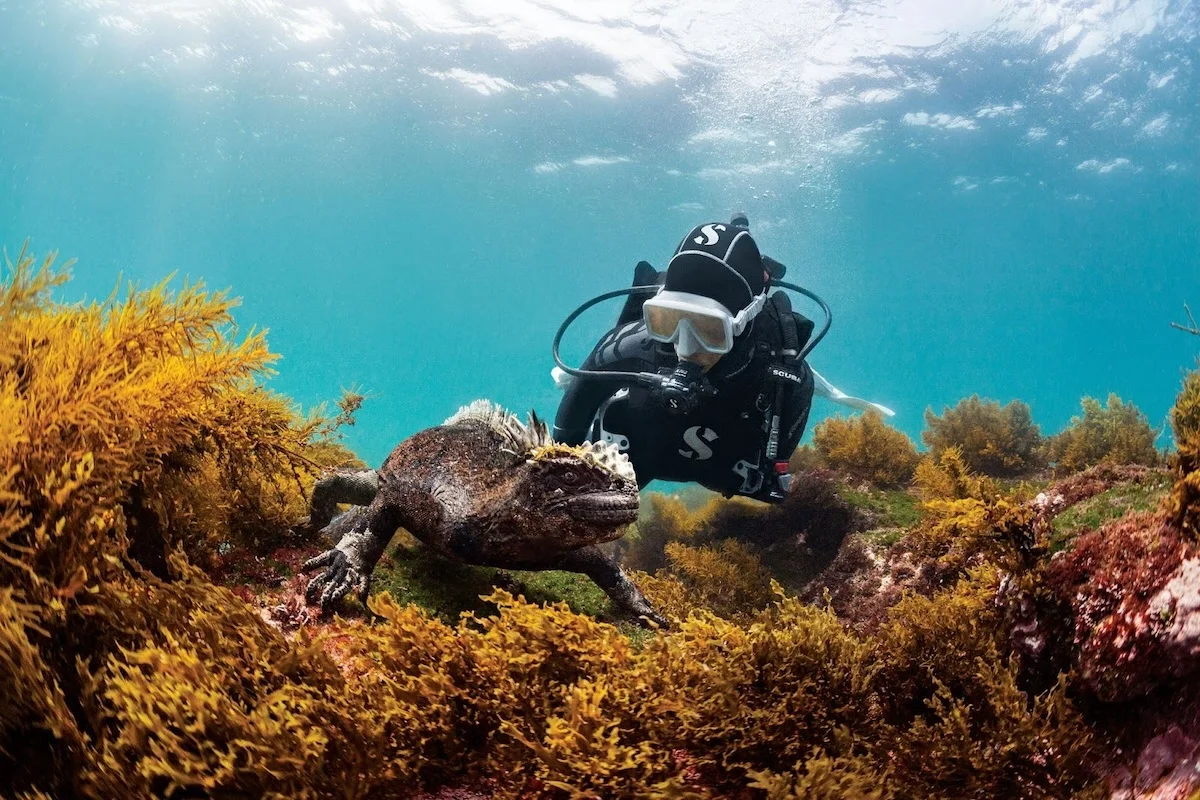
Unfortunately, Darwin’s Arch, one of the Galapágos' most famous rock formations, has collapsed into the sea due to erosion. Keep reading to see what divers loved about this area.
The rich diversity of the Galápagos island chain inspired Darwin to start exploring natural selection, changing our understanding of biology forever. Today one of the islands and the enormous stone arch at its southeastern tip bear his name. However, as far as scuba diving destinations go, scuba divers are lucky enough to explore a treasure trove of marine life just as rich as anything on the surface, and see a world that even Darwin couldn’t have dreamed of.
Located off the coast of Ecuador, Darwin’s Arch is an islet that’s a home to a diverse, teeming wilderness of marine life. Several currents converge in these nutrient-rich waters, bringing with them barracudas, bar jacks, eagle rays, sea lions, moray eels, green sea turtles, dolphins, and more.
There’s so much to see here that liveaboards often plan six or more dives here. It’s hard to get tired of a dive site when everywhere you turn has something new to see. You may even see hammerhead cleaning stations, where the sharks sit outside of the current while reef fish clean their mouths.
In addition to being an interesting sight, the sharks are much less scared of divers when they’re being cleaned, so they’re less likely to swim away from you while you get a better look or take a picture.
Other Dives in the Galápagos
While you’re in the area, you may want to check out some of the other dive sites. Most of them are volcanic in nature, with swift currents carrying huge numbers of pelagic fish. Punta Vicente Roca, a sloping wall off of Isabela Island, is home to brilliant sunfish and mola mola.
In the cold season, you may also see penguins diving in the water! Beginners may want to check out Kicker Rock, a great place for wrasse, angelfish, marine iguanas, and sea lions. This large rock off of San Cristobal Island is great for divers of all experience levels, and snorkelers too!
Maaya Thila - South Ari Atoll, Maldives
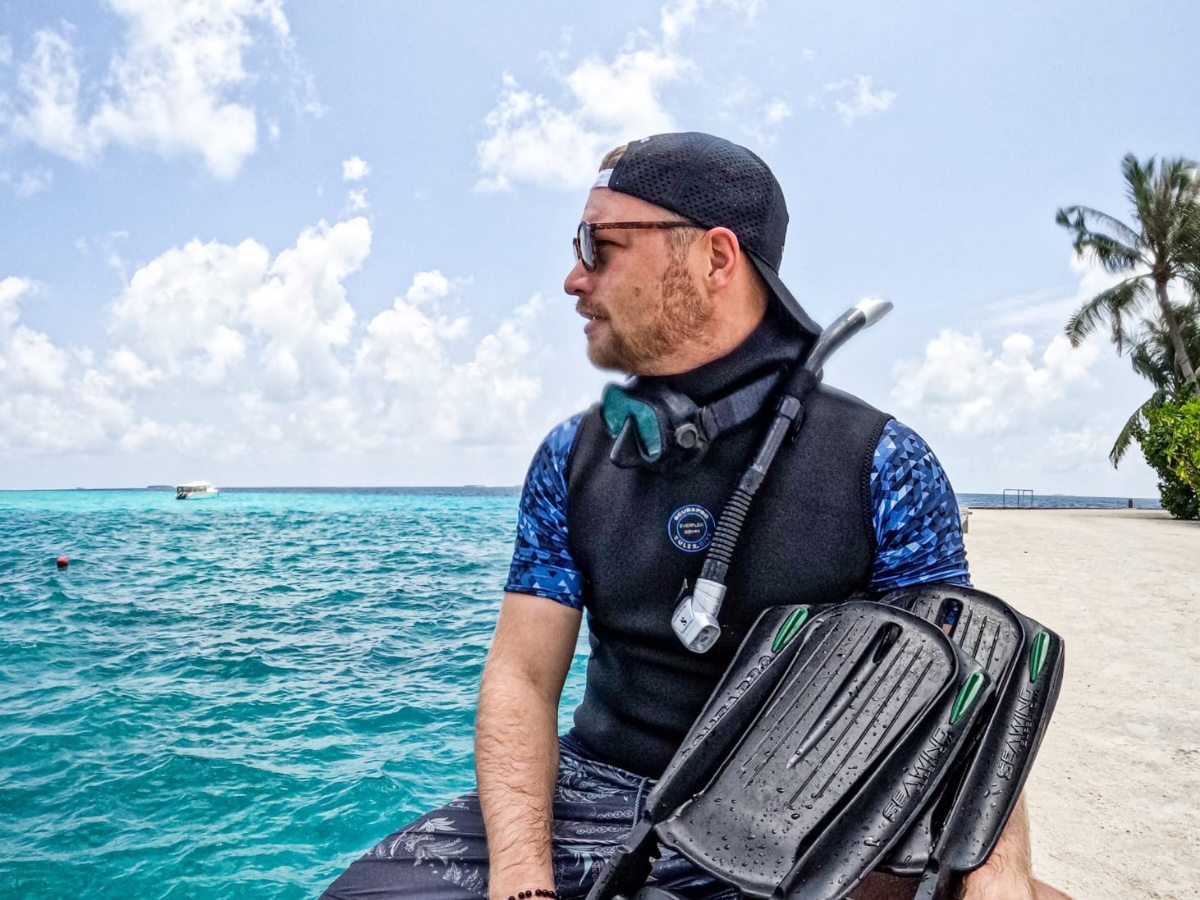
Credit: Tim Noak
The Maldives have been growing in popularity as a scuba diving destination for decades, and Maaya Thila is a great example of why. If you're looking for some of the best scuba diving in the world that hasn't been completely taken over by tourists, this is your spot. Located just northwest of Maayafushi Island, this dive site is an underwater island, capped by a shallow top reef. The area isn’t that large, around 80 meters in diameter, so if you really wanted to, you could swim the perimeter in a single dive.
Most people choose not to do that, because any given area within Maaya Thila has so much to see that scuba divers tend to stay in a small area for most of their dive.
Around the coral outcrops and caves around the Thila, you can find all kinds of sea creatures—it's one of the top scuba diving destinations for sea creatures and unique coral. White tip sharks are common, usually wherever the current is strongest. You may find wrasse and shrimp cleaning manta rays. You can also see giant turtles, dog-toothed tuna, blue-faced angelfish, parrotfish, clown triggerfish, and more.
At night is when the reef shows its true colors. If you’re looking for a great manta ray night dive, Maaya Thila has you covered. With the help of your dive light, you can also see the sharks going out for their hunts at night, and eels darting in and out of coral reefs.
When to Go Diving in The Maldives
The Maldives has great diving year-round, but the absolute best conditions are from January to April. The weather is warm and dry, and divers can experience the best visibility at this time of year. This is also when you’re likely to see the most mantas and whale sharks.
Other Great Scuba Diving Destinations Near Maaya Thila
The Maldives is an archipelago, with 26 atolls and over 1200 islands. There’s no shortage of places to explore, on water or on land. While you’re in the area, check out Sun Island, a shallow reef with a large plateau that makes it easy to spot the pelagics that love to swim by. You can see whale sharks and manta rays from early June through the end of the year.
Another great dive for shark fans is Mushi Mas Mingili Thila, also known as Fish Head. The area used to be a place where divers fed the sharks. The government put an end to the feedings, but a group of grey reef sharks still hangs out in the area. So do stingrays, scorpionfish, moray eels, barracudas, and more. You may also see a wealth of black coral, sea fans, and anemones.
Richelieu Rock, Thailand
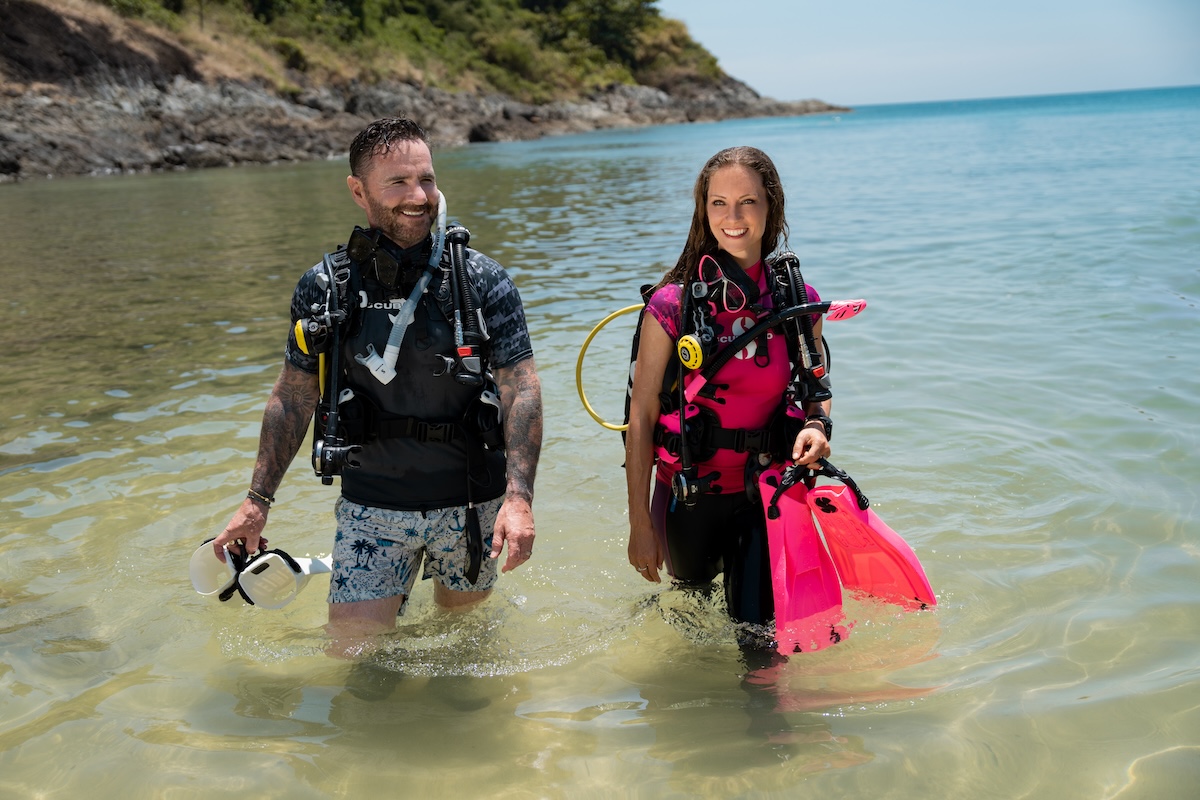
Credit: Katrin Gray / Ian Gray / Dif Underwater
In the Andaman Sea, between the Similan and Surin Islands, the water is teeming with life. Most of that life eventually finds its way to Richelieu Rock, maybe because it’s the only pinnacle anywhere nearby. This scuba diving
location is a long way from the nearest island, and even further from the mainland, making it a hotspot for any marine life in the area looking for shelter or food.
At low tide, you can see a few meters of the rock’s top, but at high tide it’s usually completely submerged. The top is covered in red and purple soft corals, and its crags and crevices are home to many small creatures like sea horses, pineapplefish, harlequin shrimp, porcelain crabs, ghost pipefish, and more. Filter feeders like manta rays, reef sharks, and whale sharks also frequent the area, as well as bannerfish, lionfish, and shovelnose rays.
A few things to know: First, the currents can be challenging, especially near the surface. If you tend to descend slowly, you may want to wait for a quiet day to dive here. Secondly, you’ll need a park permit in order to dive here. You can purchase one from the Surin Islands.
When to Go See Richelieu Rock
Richelieu Rock is part of the Surin Islands national park, and it’s only open from the 15th of October to the 15th of May. You can catch a day trip, but liveaboards are also very common, and with good reason: the dive site is huge, and so packed with sea creatures that you can spend several days exploring it without getting tired.
Other Thai Scuba Diving Destinations for a Scuba Explorer
Thailand is one of the world’s greatest scuba destinations, so while you’re in the area, be sure to check out some of the other dive sites.
Koh Bon is part of Similan Island national park, it’s one of the best dive sites in Thailand for manta ray fans. You can also find eagle rays, Napoleon wrasse, leopard sharks, and more.
En route to Richelieu Rock, you may encounter Koh Tachai, an island with several dive sites, including the famous Koh Tachai Plateau, a great haven for hard coral and a place to find plenty of swim-throughs and channels.
If you don’t see any whale sharks at Richelieu, you may want to check Koh Tachai for them to add some adventure to your scuba diving adventure.
Santa Rosa Wall, Cozumel
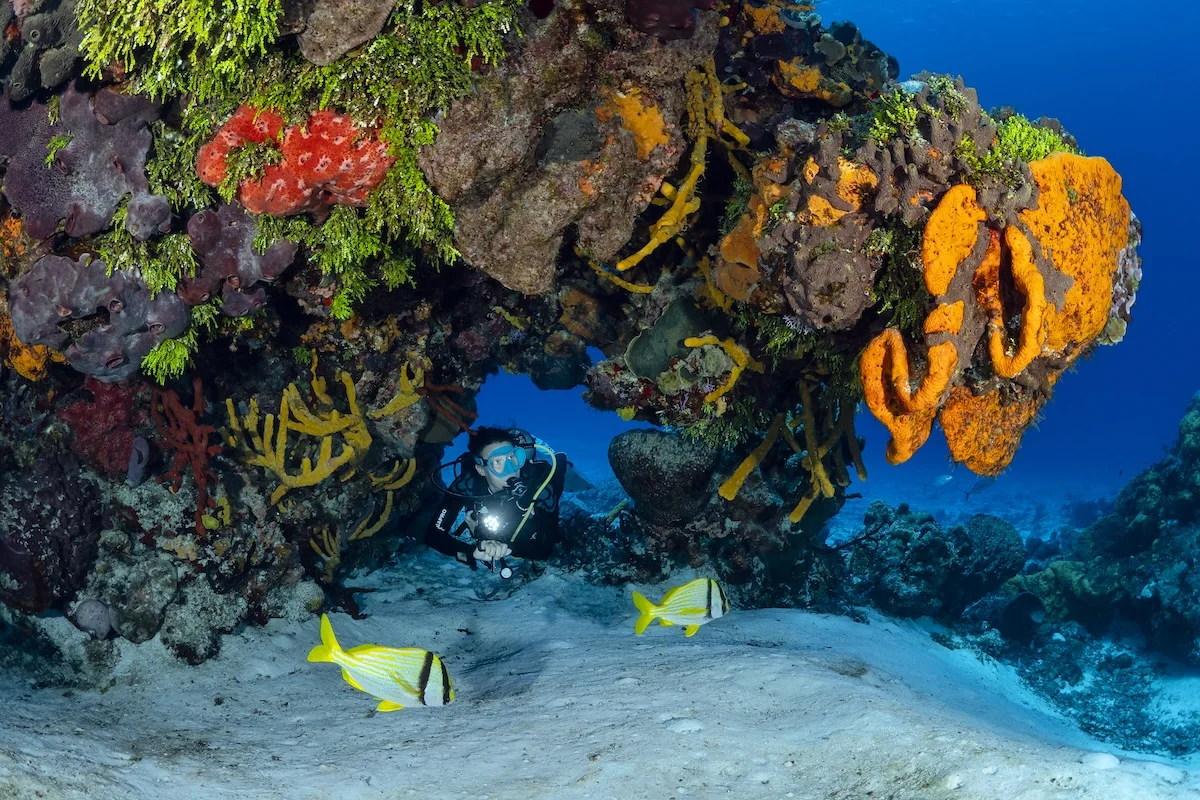
Credit: Fabrice Dudenhofer
Cozumel is one of our favorite scuba diving locations for many reasons, and Santa Rosa Wall is one of the most well known. The wall starts fairly shallow, at just 15m/50 ft, and then plunges down into the deep. The fast currents and dramatic landscape make this one of the best drift diving sites around; it feels like you’re soaring over a cliff.
There are plenty of coral species here to see, as well as giant sea fans and enormous, brightly-colored sponges. The marine life is incredible, including turtles, scrawled filefish, giant parrotfish, French and queen angelfish, and a toadfish that’s unique to Cozumel.
The dive can be fairly high-traffic. It’s an awe-inspiring dive site, and it’s just a short distance from San Miguel. You may want to check it out in the afternoon, when it typically isn’t as crowded.
While drift diving along the wall is incredible, another strategy is to make Santa Rosa your second dive of the day, and glide along the top of the wall. The shallower parts of the wall don’t have as many divers, and the marine life is incredible there.
Tip: To learn about more Cozumel diving locations check out our Cozumel Diving Guide. The guide easily shows why we have it down as one of the best scuba diving in the world locations.
When to Go Dive Santa Rosa Wall
The average water temperature varies, but stays pretty warm year-round. It ranges from an average of 75 degrees in winter to 85 degrees in the summer. However, the hurricane season does run from June to November, so if you want to avoid storms, book your trip for the rest of the year.
Other Dives Around Cozumel
While you’re in Cozumel, check out coral pinnacles like Columbia Deep, Palancar Horseshoe, or Punta Sur. These huge coral formations have grown up and fused together, creating a maze of brilliant tunnels, archways, and swim-throughs for your scuba diving adventure.
There are coral pinnacle dive sites available for divers of all levels, but for advanced sites like Punta Sur, you may want to ask your operator to take you out there early in your stay. Trips to some sites are only done on request, and the operator may need time to get enough divers to make the trip.
If you’re into wreck dives, check out the C-53, also known as Felipe Xicotencatl. Formerly a minesweeper in the Mexican Navy, this 184-foot ship now sits on the white sands of Chankanaab Bay as an artificial reef.
The wreck is huge and best for experienced divers, but the interior is marked with permanent lines showing divers through the wreck.
SS Thistlegorm Wreck, Egyptian Red Sea
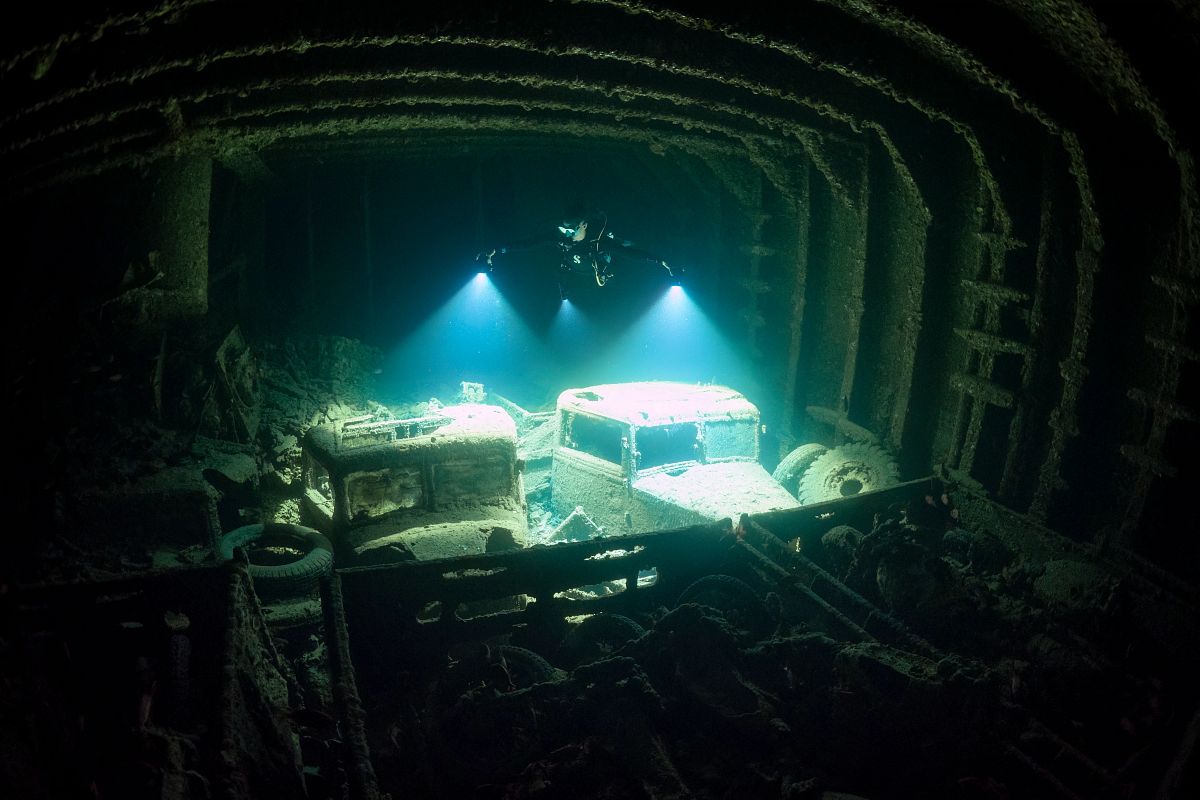
Credit: Fabrice Dudenhofer
The Thistlegorm is one of the world’s most iconic wreck dives, and one of the most captivating to explore. This 415-foot steamship was launched in 1940, and while it wasn’t built for combat, it was quickly fitted with outdated weaponry and pressed into the war effort.
Thistlegorm made several voyages carrying supplies around the world before being sunk into the Egyptian Red Sea by the Luftwaffe in October of 1941.
The bombing split the ship in two, but despite being in two pieces, its structure is incredibly well-preserved, and so is the weaponry, trucks, tanks, and even trains that the Thistlegorm was carrying.
The stern lies on its port side at 105 feet. Here you’ll find the enormous propeller, a couple of Mark II Bren Carrier Tanks, and a pile of rubble and debris from the bombing. You can also see the enormous anti-aircraft guns that were mounted to the deck.
The ship’s bow sits upright, in shallower water at about 52 feet deep. The bow has three intact cargo holds full of grenades, mines, cars, trucks, motorcycles, and more. You can also see vintage boots, old hospital and radio equipment, and all kinds of other supplies.
Divers may also encounter the boat’s new residents, which include soldierfish and sweepers, crocodilefish, hawksbill turtles, and more.
The wreck is fairly remote. It’s about a four-hour boat trip from Sharm el Sheikh. Despite the difficulty reaching it, it’s an incredibly popular site, and can fill up quickly.
If you want some elbow room, consider taking a liveaboard tour and exploring the site in the morning, while the day boats are still making their journey.
When to Dive the Red Sea
The best time to scuba dive is either March to May (the spring months, when the air and water are comfortably warm) or September to November (the autumn months, where the temperature begins to cool down to comfortable levels again, and when thresher sharks swim the Sudanese and Egyptian waters, and you can see manta rays around Sudan).
Of course, the off-season has its privileges, too. December to February can get windy, making waters uncomfortably choppy on the surface. But the visibility is fantastic, and it’s the best time to see an oceanic whitetip shark in Egypt or a hammerhead in Sudan.
Other Scuba Diving Locations Around the Red Sea
Sharm El Sheikh is one of the biggest diving hotspots in the area, but outside of that city, there isn’t a ton of infrastructure for diving along the coast. A liveaboard may be your best bet.
It’s worth the effort, though. The Red Sea has 1,000 species of invertebrates and 1,100 species of fish, over 20% of which can only be found in the Red Sea.
Ras Mohammed National Park is on the southern tip of the Sinai Peninsula, very near to the Thistlegorm wreck. Here you’ll find over 220 species of coral at reefs like Shark Reef and Yolanda Reef.
Preserving this area has been a top priority for the Egyptian government since Sinai was returned to Egypt, and that effort is visible whether you’re diving in the crystalline waters or taking in the mangrove trees and acacias topside.
SS Yongala Wreck - Great Barrier Reef, Australia
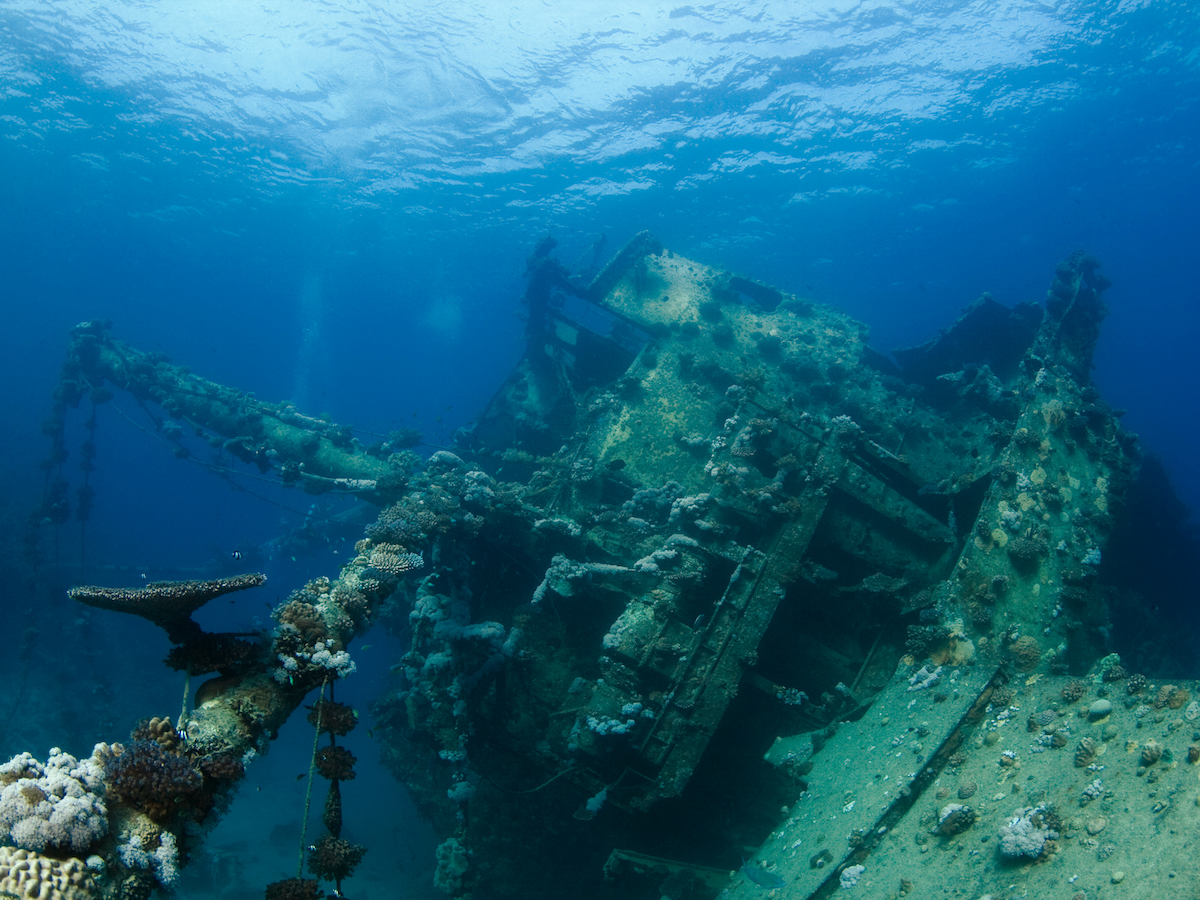
Another famous wreck dive, the SS Yongala sank off Cape Bowling Green in 1911 after a run-in with a cyclone. The 350-foot steamer lies on its starboard side 33 meters down, about 12 nautical miles out of Alva Beach. Because of its remote location, it wasn’t discovered until 1958.
There are a lot of reasons to explore the Yongala. For one, the wreck is incredibly well-preserved. The ship was constructed in 1903, so explorers get to see a ship that’s been around since the turn of the last century.
The other big attraction is that the shipwreck is the only landscape feature in the ocean for a long way in any direction. That means that over the last 100 years underwater, it’s become a vibrant coral reef that attracts all kinds of sea life. Any creature traveling these waters that wants to grab a bite or find shelter is going to stop by the wreck. That includes the giant trevally, the bull shark, the chevron barracuda, the Queensland groper, and more.
Ray fans can find spotted eagle rays, marble rays, and smalleye rays, and you can also find several varieties of sea turtles, like loggerheads and hawksbills.
Penetration dives aren’t allowed at the wreck, as oxygen from bubbles can corrode the structure. Dive operators (and heavy fines) enforce this rule. But the dive is an all-time great, all the same, as it’s one of the most vibrant underwater ecosystems around.
When and How to Dive the Yongala Wreck
Visibility is never incredible in the area, averaging out to around 15m year-round. But visibility is slightly better in the winter season, from June to August. You can head out from Townsville by boat, but you’re in for about a 3-hour trip.
If you want a shorter journey, you can head out from Alva Beach. The beach, located near Ayr, is a longer trip topside, but the boat trip is only about 30 minutes.
Alternatively, you can take a liveaboard tour and get the full Great Barrier Reef explorer experience. Please note that between the visibility, the landscape, and the depth, the Yongala wreck dive is best for experienced divers.
Other Scuba Dives in Australia
While you’re in the area, you have to explore the Great Barrier Reef properly. Stretching for 2,300 kilometers, a scuba diver could explore this reef for ages and never see it all.
There’s honestly too much of the reef to think of it as a scuba diving site. It’s more of a diving world. Whether you head out from Cairns or Port Douglas, you’ll find trips for all skill levels. A liveaboard is a great way to catch the wreck and the reef in one go.
There’s also the Southern Great Barrier Reef near Bundaberg. This reef is lesser-known, but well worth the time. A series of gorgeous islands play host to a coral landscape filled with brilliant tropical fish.
Heron Island has 20 dive sites nearby by itself, and that’s before you get to Lady Elliot and Lady Musgrave Islands, with their manta rays, guitar sharks, and leopard sharks.
For more excellent diving locations and destinations in Australia we recommend reading Scuba Diving Australia: Top 15 Dive Spots.
Yolanda and Shark Reef, Egyptian Red Sea
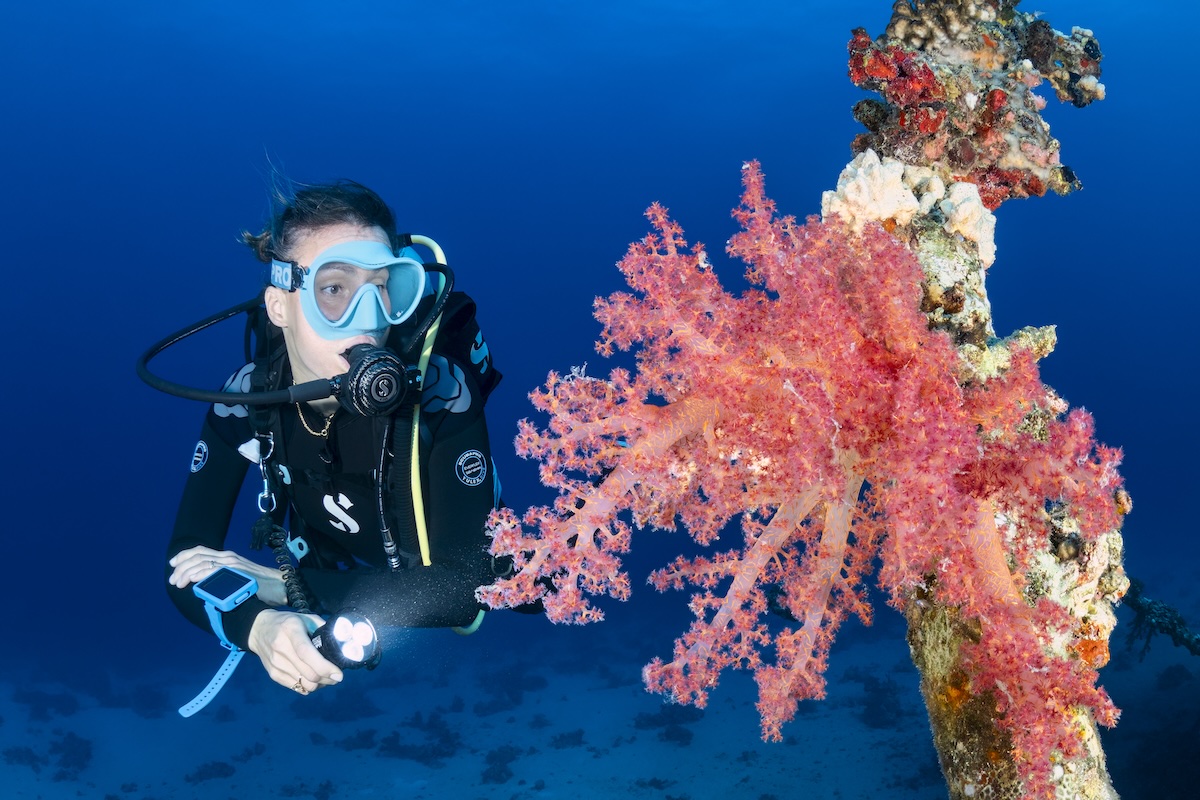
Credit: Fabrice Dudenhofer
Shark Reef and Yolanda Reef are in the Egyptian Red Sea in Ras Mohammed National Park, not far from the SS Thistlegorm wreck. These two reefs rise up from a seabed just around 20-30 meters deep. Here you’ll find a deep wall, a sandy plateau, and a wreck, all in one place.
Large schools of barracuda frequent the site. In July and August you can even see silky sharks! The Suez and Aqaba gulfs meet here, meaning that this spot has two different currents and two sets of endemic species mingling in one location.
You can find soft corals, sea anemones, and parazoanthus covering the wall here, and when the current dies down, the soft coral opens up and the reef becomes an explosion of color and life.
The Yolanda sits at a lower depth, around 145-160 meters. This Cypriot cargo ship was grounded on a reef in 1980. Today, the wreck is a tourist destination not only for the fish life, coral, and marine creatures that live here, but also for the unusual cargo.
The SS Thistlegorm was full of bathtubs, pipes, and toilets when it went down, making this site the home of some of the most famous toilets in the world.
When to Visit Yolanda and Shark Reef
There’s no wrong time to visit. The water and air temperature are best in spring and autumn. However, winter visitors can find incredible visibility of 50 meters or more, and juvenile fish in the prime of their lives. Going in summer (June to September) means you can see huge schools of fish, including jackfish, snappers, batfish, and more.
1000 Steps, Bonaire
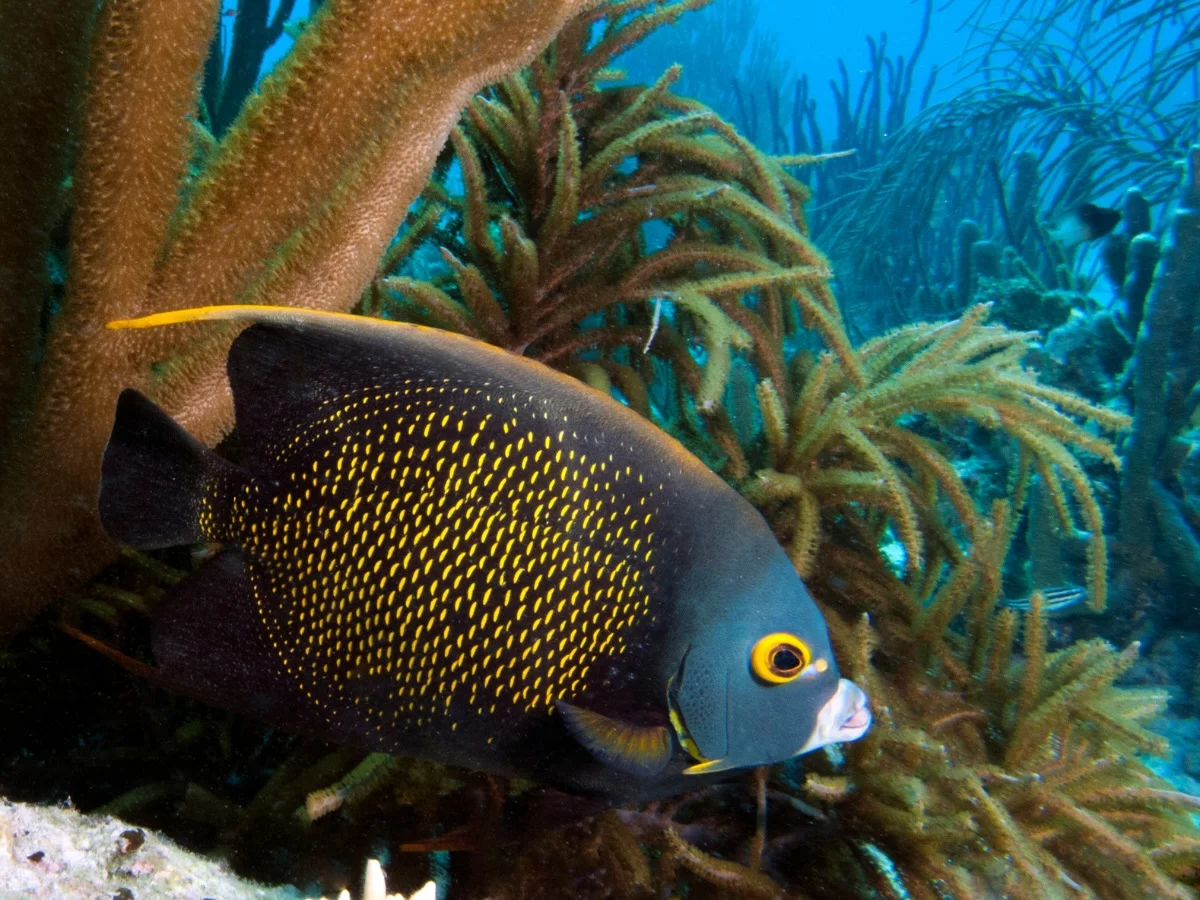
Bonaire is at the top of scuba dive bucket lists around the world. It’s a diving paradise, and 1000 Steps is just one of the reasons why. 1000 steps is named for the limestone steps you descend to reach the beach. (Don’t worry about the name; there are really only about 67 steps.)
Once you make it down, you’ll find gorgeous white sand on a cove surrounded by limestone cliffs. If you don’t mind toting your gear down, you can shore dive from the beach.
In these shallow, turquoise waters, divers can find sea turtles, parrotfish, blue tangs, and squirrelfish flitting among brain and staghorn corals, gorgonide rods, and more. And while the dive is a vibrant one, it isn’t particularly challenging.
Even snorkelers can find plenty to enjoy. And for those who don’t dive, 1000 Steps is worth the trek out just for the view from the top of the steps.
When to Visit Bonaire
Part of what makes Bonaire such a great destination is that the temperature is pretty perfect year-round. The waters of the Southern Caribbean are warm and comfortable no matter when you go.
The official diving season runs from December to April. That’s when the weather is best (and when tourism is highest). The windy season runs from May to August, and from November to January, the rainy season will bring rainstorms that are typically very light, but which happen daily.
Other Scuba Diving Destinations in Bonaire
Bonaire is an absolute jewel of the Caribbean, and alongside Aruba and Curaçao, part of the “ABC” chain of islands. You can explore the wider Caribbean, or you can just keep enjoying Bonaire.
One popular wreck dive near the island is Hilma Hooker. This 236-foot Dutch freighter was launched in 1951 as Midsland. Since then it changed names and owners several times over the decades.
Eventually, the boat was used as a drug smuggling ship, and Bonaire officials caught it in 1984 with 25,000 pounds of marijuana stowed away behind a fake bulkhead. For months, locals tried to get the boat sunk to create a new dive. But the boat couldn’t be sunk, because it was being used as evidence in an active court case.
The fight over the ship’s fate went on until finally, the boat sank on its own, rolling to the starboard side and plummeting into the water two minutes later.
The ship’s bizarre history is good fortune for divers, who can find yellow snapper, angelfish, and tarpon in and around the ship. Enormous sponges have taken over the propeller, and corals grow along the hull and on two reefs on either side of the ship.
Another great reef dive is Bari Reef. With 300 fish species, this reef is the top spot for fish diversity in all of the Caribbean. Like most Bonaire dives, you can reach it from the shore. Explorers can find at least five kinds of parrotfish, blue tangs, two kinds of filefish, barracudas, and more.
What are Your Favorite Scuba Diving Destinations?
These are some of our favorite getaways, some of the best scuba diving experiences we’ve found. But there are so many fantastic opportunities for diving in the world. It’s impossible to talk about the best diving without leaving someone’s favorite out. So, you tell us! Where do you think is the best scuba diving in the world? Maybe some of your favorite locations are diving spots in the United States.
What’s your favorite dive destination? Maybe it’s one on our list! Maybe you want to talk about diving with humpback whales in French Polynesia or Costa Rica. Maybe you love to explore shipwrecks in the Great Lakes. Speaking of lakes, there are plenty of amazing freshwater and lake scuba diving locations in the U.S. to explore.
Maybe you are looking to plan a snorkeling trip with family or friends. Get inspiration and ideas from some of the best snorkeling spots in the world.
There’s more incredible scuba diving in the world, and we want to hear about it. Find SCUBAPRO on Facebook, Twitter, or Instagram, and let us know!






